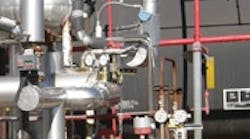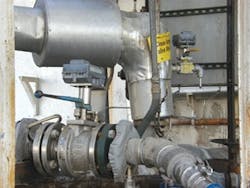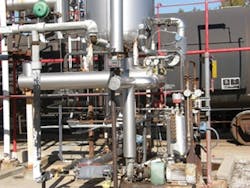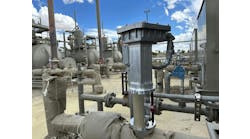By Kevin Root, Harcros Chemicals
At our facility in Kansas City, Kan., four manufacturing units are situated on approximately 100 acres. Our alkoxylation unit adds ethylene oxide or propylene oxide to produce our T-DET surfactants and other specialty adducts. The surfactants are shipped in current form or further processed into phosphate ester surfactants, ether sulfate surfactants or our T-MULZ emulsifiers. We do about 200 different products at this unit, and a lot of the products are dissimilar enough that they require washouts during a changeover.
A valve left open after a washout can have dangerous and expensive consequences.
Primarily, we wanted to minimize employee exposure because we're around some pretty severe chemicals. On the environmental side, there would be serious issues if these valves were left open and we put material on the ground. We deal with some dangerous chemicals, so this could have a severe impact on the environment.
Test the Waters
In the fall of 2008, Harcros decided to eliminate the risk of an employee putting a foot in a dangerous chemical spill by dipping its own toe in the wireless water.
"We put the wireless on to verify the valve position," says Lloyd Hale, director of manufacturing at Harcros. "It was cost-prohibitive to hardwire because of location. We're a batch operation, so these valves are open after each batch when we do washouts, and these valves are tough to get to. A person has to reach up through the piping. We turn reactors around almost every day, so the potential to miss a valve is always there when you're dealing with the human factor, and we needed to verify the valves were closed prior to a batch. We also wanted to put wireless into a non-critical application to build our confidence in its reliability."
A lot of opportunities for wireless applications exist at our site. Before we undertook any major capital improvements, we wanted to prove the reliability of wireless so we can approach other applications with confidence.
The only alternative to wireless that Harcros considered was switching to positive-close, spring-loaded valves that would have to be held open and then would self-close. "But during washouts that would be hazardous to the employee holding open the valve," explains Hale.
Because the DeltaV control system already was in place, Harcros turned to Experitec (www.experitec.com), its local Emerson representative. "We wanted to be sure we could communicate with our current control system, DeltaV," explains Hale. "Experitec put us in contact with Emerson to evaluate the right valve monitors. Emerson sent a rep down from the Fisher division in Marshalltown, Iowa. We're at capacity, so we couldn't shut the unit down very often. It's a 5/24 plant, but we normally work every other weekend. The contractor scheduled for its people to come in when the unit was down. It took about five months."
Valve Feedback Without Wires
Most process plants have situations similar to Harcros Chemicals, relates Terry Buzbee, president of the Fisher division at Emerson Process Management (www.emersonprocess.com/fisher). "They might have hundreds or even thousands of valves that aren't connected to the control system because of high wiring costs," he says. "These valves therefore provide no feedback on their actual positions, even though incorrectly positioned valves represent a significant cause of safety-related incidents."
Harcros' use of manual valves for sampling, directing, injection and extraction processes at its facility means many of the valves are in remote, hard-to-reach locations too costly to access with wires. "Monitoring them was a difficult process, requiring operators to enter hazardous areas or climb ladders to check the valves' state or position," adds Buzbee.
"In the past they had to send someone out to the valve to check on it," explains Kurtis Jensen, Fisher instrument product manager at Emerson Process Management. "These valve monitors update every minute. They know the state of the valves at all times. The critical periods in production occur after they have rinsed the reactors and are ready to fill with the product mixture." A valve in the wrong position is the cause of product spills or a bad product.
Turnkey Redundancy
Emerson configured everything. When they left, it was all online and operational, and the redundancy of the mesh network was critical to its reliability.
"Harcros, like most, if not all, customers, is looking to increase confidence in its processes," says Jensen. "Coming to them with less-than-reliable products would be a disservice. Of paramount importance is reliability in communications. The only way to get that today is with a wireless network that builds a mesh between the wireless gateway and each and every device. The devices must be able to reroute communications in case there are changes or interruptions in the network. The only network that can do that is WirelessHART. The 21 devices at Harcros form a mesh and route traffic to the gateway. Most of the devices communicate directly with the gateway, but they also formed secondary, tertiary links between themselves to build the meshing."
The gateway is connected to the control room with about a half-mile of fiberoptic cable, and the antenna for that gateway is on top of the control room. Each device is about 150-200 ft apart, so it's pretty consolidated. "The gateway communicates to the DeltaV system 9.3 when installed via Modbus communications," explains Jensen. "They have recently upgraded to version 10.3 and will convert to native I/O communications."
Harcros has several different manufacturers of valves needing adaptation of the position monitor. "We have valves from four different manufacturers and there are different mounting requirements, even within the same manufacturer's valves," says Hale. "The only problem we had was with the valve mounting brackets and covering all the variations. This took effort and communication but was solved, and we moved on. In the end, the network tied into our control system and came online beautifully."
Improved Safety, Avoided Clean-Up
The Harcros facility has documented numerous benefits from the wireless instrument applications, and total savings were far beyond the direct cost reductions of a no-wires installation. "This was about eliminating mistakes and increasing safety," says Hale. "Wireless valve position monitoring enabled us to reduce inadvertent emissions and bad batches, as well as avoid the high costs of rework, clean-up and lost material. Eliminating these costs —up to $25,000 per incident—is a good thing for our plant."
At Harcros, worker safety is a primary concern, not only because of the location of the valves, but also because of the toxic chemicals the valves contain and control, states Hale. "The facility uses propylene oxide and ethylene oxide for its processing operations, and exposure to either one can irritate a person's eyes, skin or respiratory tract," says Hale. "Leaks involving toxic chemicals can also result in expensive fines. Adding 21 wireless position monitors to these isolated, manual valves enabled Harcros personnel to identify inadvertent emissions before they could result in costly fines or production delays. The wireless monitor units helped us avoid three product-release incidents, saving at least $75,000."
The Future's So Bright …
Besides applying the Fisher wireless position monitors to more of our manual valves, we are considering Emerson Smart Wireless technology for tank-level management, rail-car monitoring and a host of temperature, pressure and flow applications at our Kansas City site.
As we lose hardwired devices through attrition, the gateway cost has already been incurred, so we're looking to replace those with wireless devices. The beauty of the wireless is that as you add instruments, the system becomes more robust because these instruments talk to each other. We already have the wireless units on-plant, and they should be tied in to the DeltaV soon. We also may be bringing in boiler parameters, other non-critical valves and some temperature indication on exchangers to the DeltaV.
Kevin Root is unit manager at Harcros Chemicals. Find out more about Harcros at www.harcros.com.
Sponsored Recommendations

Leaders relevant to this article:





